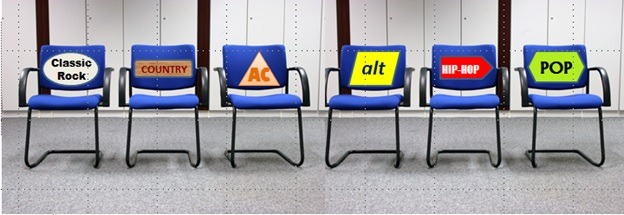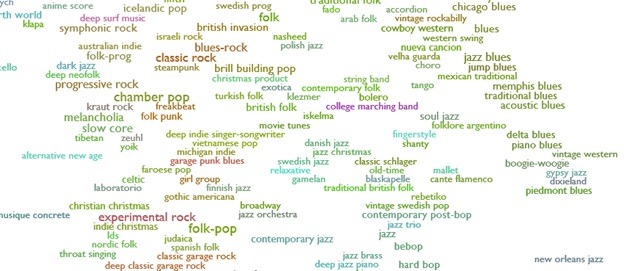Radio is an industry whose foundation is formats. It’s how stations are defined – by agencies and ultimately, by the audience. Radio has created a language and a nomenclature so that listeners and marketers can understand the lay of the land. In fact, it allows for us to do business with one another. When we hear that a new Country station just signed on in Denver, we know the drill.
We conduct research to identify “music lanes” and “music recipes” – all predicated on the standard format definitions. Fragmentation has changed the game somewhat. I like to think that Classic Rock was the first true format divider for what was known back in the ‘70s and ‘80s as AOR – or Album Oriented Rock. In the years since, Classic Country, Hot AC, Classic Hip-Hop, and many other fragmented formats have been created, often disrupting the original “big tent” format.
But artists and bands have often pushed back at this notion of formats. No example was more bombastic than the mashup between Run-D.M.C. and Aerosmith with “Walk This Way,” a video that once viewed by Rockers and Hip-Hop fans could not be unseen. Produced nearly three decades ago, their collective version of a rock anthem literally and figuratively broke the wall down between the two formats, sending a message to a radio industry that basked in the comfort of well-defined formats and musical silos.
Email recipients: Click here to watch “Walk This Way” by RUN-DMC & Aerosmith
And since then, many big name artists have actively broken the format line to make a name for themselves in another genre. From Darius Rucker, formerly of Hootie & the Blowfish, to Kid Rock, many have gravitated to the Country format, seeking larger audiences that transcend the Pop and Rock genres.
And now comes word that Steven Tyler is at again, signing with Big Machine to make a solo Country album. Aerosmith’s Tyler says this transition will be a smooth one as he told Rolling Stone: “I think country is the new rock & roll. I grew up in the woods of New Hampshire. . . I have more country in me than people think.” (And Hip-Hop and probably Classical.)
Tyler’s timing is interesting because maybe there’s a swingback underway, as some core Country artists are exploring other musical genres, starting with Taylor Swift and 1989 last year, and continuing with the Zac Brown Band’s “Heavy Is the Head” – charting Top 5 in Mediabase this week in both the Active and Mainstream Rock charts. On Country? They’re playing a different track.
Here’s “Heavy Is the Head” from an appearance on Saturday Night Live last month featuring rocker Chris Cornell:
>Email recipients: Click here to watch Zac Brown Band featuring Chris Cornell<
Taylor Swift’s “Style” is Top 5 on both Hot AC and CHR. Yet, she’s MIA on the Country charts. So what’s going on here? Are artists purposefully “genre busting” – going outside the defined format lanes to reach new audiences – and in the process, daring the radio stations that helped make them stars to play their newest efforts?
WMMR’s Bill Weston told Billboard last month, “We saw in Dave Grohl’s Sonic Highways that [Brown] is the genuine article flying in the face of conformity in the Nashville music scene. Now, we get a gritty rock track with Cornell. It begs not the question, ‘Why now?,’ but, ‘Why not now?’”
So maybe it doesn’t matter and the Zac Brown Band can have it both ways. Their “Homeland” tops the Country charts while “Heavy Is the Head” dominates both Rock playlists. And they certainly don’t care whether they ruffle anybody’s format sensibilities.
And that speaks to the growing degree of interest driven by consumers who are doing lots of “genre busting” of their own. Maybe it started with iPods as music collections were created that often went well beyond formatic boundaries. “Guilty pleasure” songs ended up on playlists that people enjoy listening to, even if they seemingly contradict an individual’s core tastes. How many hardcore rockers have playlists with songs by Bread, Stories, or even the Bee Gees? People’s true music preferences are not siloed even if their radio stations are.
We see this playing out on Spotify as tastes continue to fragment before our eyes. Here’s a graphic from their “Every Noise” interactive chart that shows just a small portion of the hundreds of genres, sub-genres, and styles that Spotify notes and tracks. On the interactive link here, you can mouse over any genre, see a representative song, and hear its hook:
This suggests that “The Long Tail” of pop culture – made tangible by platforms like Amazon for books and films, and Netflix for streaming video – is impacting many different art forms.
And when it comes to music, the taste sphere is expanding as consumers truly become more eclectic, pushing programmers to rethink format boundary lines. Are listeners loyal to a sound – or to an artist? Are Rockers interested in a Steven Tyler song recorded for release on Country stations? Do Country fans want to hear Taylor Swift’s newest release even though it doesn’t sound like her core product?
These questions can be researched, of course, but broadcasters will have to create and frame different questions that can speak to these issues.
The lines are blurring as technology enables wider arrays of tastes and styles.
So what’s on your turntable, iPod, or in your cloud?
- Can Radio Afford To Miss The Short Videos Boat? - April 22, 2025
- Media And Technology In 2025: Believe It Or Not! - April 18, 2025
- In Radio, You Just Never Know - April 17, 2025






GREAT CHART. Invent and create. What a concept!! IMHO the kids of the 60s who started FM are now in their 60s and more than ready to apply seasoned experience to advanced & connected audio. Spread sheets don’t do the creative. People do. Thank you, Fred.
Appreciate it, Clark.
Great writing, Fred. Important article for today’s radio executives.
It’s also very important for today’s programmers to accept the fact that except for aging Baby Boomers, all format lines and self-professed format descriptions have been blurred for some time, with maybe the exception of Country Music.
Watch any TV music show or check out the iTunes home page to see that people under 50 could care less about terms like Rock, Adult Contemporary, Pop or Rap. They are helpful reference points when “looking for something in particular”, like songs to download, but as far as daily listening goes, “civilians” do not describe themselves as listeners of formats. They like what they like and have a much more open mind regarding new music and different styles. Today’s successful radio stations are playing a longer list of songs from all format categories, and using general format self-descriptions often to the amazement of us old, programming dogs. The success of online listening is proof that people have far more liberal tastes than we might wish for. The other news that will change entertainment listening in a big way, is Chevrolet’s announcement that all of their new cars will include on-board wifi, thus taking away radio’s biggest advantage in away-from-home choices.
Brave new world, Jim. I think you’re right that Boomers still adhere to those boundaries (maybe it was the anti-Disco movement that drove that), but for the rest of the world, diversity in music (and beyond) is the leading edge emotion. Thanks for putting a point on it, and thanks for reading our blog.
Thanks for a very interesting piece, Fred. Having been a buyer when a market had a couple of Top 40 stations, an MOR station, a Country station or two, a News station, and a Beautiful Music station, and you could tell which was which when you listened, and when you looked at the demos, I understand the conundrum. But I have to say, musicians crossing from one genre to another is a natural occurrence. Experimentation and innovation have been the driving force behind the evolution of all modern music.
Think about Jazz and Blues. Jazz arose from the tub bands of the post-Civil War, and evolved through Ragtime and Swing to Bebop and Cool Jazz and Fusion to experimental sounds and more. If you adhere to the old adage, the story includes the birth of Rock and Roll. And talk about your blurred lines? Last week, the host of my station’s New Orleans sound specialty show played a cut by an Indie Rock band that my son had listened to when he was a teenager!
I think the point is that the more experience a person has with music, e.g. the more sophisticated his or her taste becomes, the more demanding the listener becomes in terms of musical style. The simple old days of defining the Top 40 audience as 12-24 just doesn’t work anymore. I had the luck and the delight to see Buddy Guy, in concert last weekend. There were kids in the audience, under 12, digging the sounds every bit as much as Gran and Gramps in the seats next to them.
The challenge for radio, and especially in my experience in the Public media world, is to define my station not by size, or even by demo, but by psychographic quality. It’s not easy, but it can be done.
Ann, your perspective is so valuable to this conversation. And you’ve identified the way that music works as a series of Venn diagrams, overlapping each other. You can see that in the chaos of the Spotify chart.
And I believe that psychographic quality is speak relates to the emotional quality that a station brings to the table, uniting listeners from different demographic groups. We are seeing this more and more with the Classic Rock, as the audience continues to expand to age groups that weren’t alive when the music became popular. Appreciate you commenting.